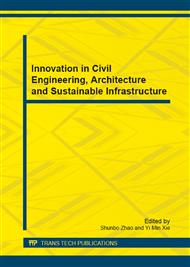[1]
P. Lam, E. Chan, C. Poon, C. Chau, K. Chun,, Factors affecting the implementation of green specifications in construction, Journal of Environmental Management, 3 (2010) 654-661.
DOI: 10.1016/j.jenvman.2009.09.029
Google Scholar
[2]
GBCA, The dollars and sense of green buildings, Green Building Council Australia, Sydney, 2008.
Google Scholar
[3]
I. Mosly, G. Zhang, Review of risks for the implementation of energy efficient and renewable technologies in green office buildings, in: Proceedings of the Sustainable Building Conference, Wellington, New Zealand, May 26 – 28, 2010.
Google Scholar
[4]
L. Lombard, J. Ortiz, C. Pout, A review on buildings energy consumption information, Energy and Buildings, 3 (2008) 394-398.
DOI: 10.1016/j.enbuild.2007.03.007
Google Scholar
[5]
P. Torcellini, S. Pless, M. Deru, Zero energy buildings: A critical look at the definition, ACEEE Sumer Study, Pacific Grove, California, 2006.
Google Scholar
[6]
M. Modarres, Risk Analysis in Engineering: Techniques, Tools and Trends, Florida CRC Press, Taylor and Francis Group, 2006.
Google Scholar
[7]
AS/NZS, Risk management guidelines companion to AS/NZS 4360:2004, Australia/New Zealand Standards, Wellington, 2004.
Google Scholar
[8]
I. Mosly, G. Zhang, Study on risk management for the implementation of energy efficient and renewable technologies in green office buildings, in: Proceedings of the Transition to Sustainability Conference, Auckland, New Zealand, November/December 30 – 03, 2010.
Google Scholar
[9]
B. Sovacool, The importance of comprehensiveness in renewable electricity and energy efficiency policy, Energy Policy, 4 (2009) 1529 – 1541.
DOI: 10.1016/j.enpol.2008.12.016
Google Scholar
[10]
A. Singh, S. Srivastava, R. Shrestha, Barriers to adoption of clean and efficient technologies in the Indian power sector: an analysis using AHP, in: BAQ Conference, Yogyakatra, Indonesia, December 13 – 15, 2006.
DOI: 10.2139/ssrn.3440327
Google Scholar
[11]
J. Pinkse, M. Dommisse, Overcoming barriers to sustainability: an explanation of residential builders reluctance to adopt clean technologies, Business Strategy and the Environment, 8 (2009) 515 – 527.
DOI: 10.1002/bse.615
Google Scholar
[12]
B. Reddy, R. Shrestha, Barriers to the adoption of efficient electricity technologies: a case study of India, International Journal of Energy Research, 3 (1998) 257 – 270.
DOI: 10.1002/(sici)1099-114x(19980310)22:3<257::aid-er358>3.3.co;2-3
Google Scholar
[13]
J. Painuly, Barriers to renewable energy penetration; a framework for analysis, Renewable Energy, 1 (2001) 73 – 89.
DOI: 10.1016/s0960-1481(00)00186-5
Google Scholar
[14]
H. Feustel, C. Stetiu, Hydronic radiant cooling– preliminary assessment, Energy and Buildings, 3 (1995) 193 – 205.
DOI: 10.1016/0378-7788(95)00922-k
Google Scholar
[15]
M. Henderson, Application of chilled technology in modern office buildings, in: Natura Hybrid or Air-conditioning Conference, Melbourne, Australia, September 17, 2003.
Google Scholar
[16]
G. Zhang, J. Yang, Factors influencing the implementation of the raised floor system in Australian office buildings, Construction Management and Economics, 5 (2006) 529 – 543.
DOI: 10.1080/01446190600568025
Google Scholar
[17]
P. Hinton, C. Brownlow, I. McMurray, B. Cozens, SPSS explained, Routledge, Hove, United Kingdom, 2004.
Google Scholar
[18]
J. Mankins, Technology readiness and risk assessment: A new approach, Acta Astronautica, 9-10 (2009) 1208-1215.
DOI: 10.1016/j.actaastro.2009.03.059
Google Scholar
[19]
A. Field, Discovering Statistics using SPSS, 3rd edt, SAGE publications Ltd, London, United Kingdom, 2009.
Google Scholar


